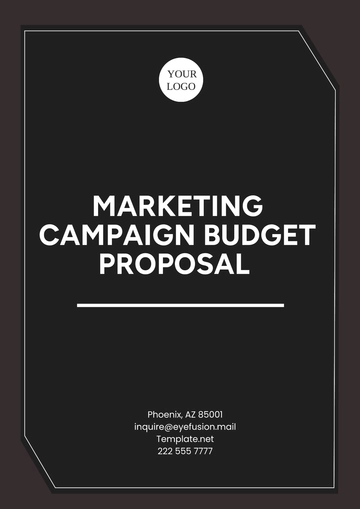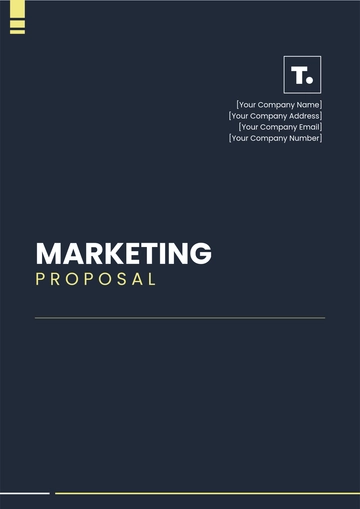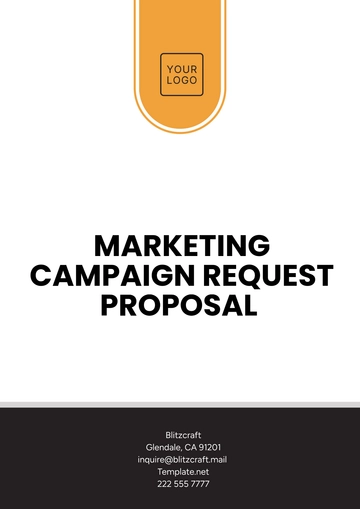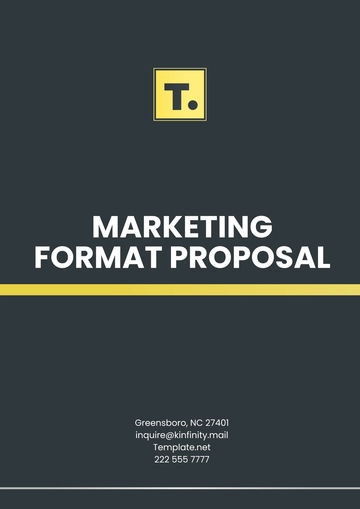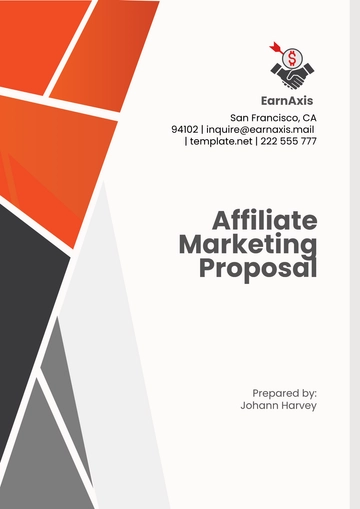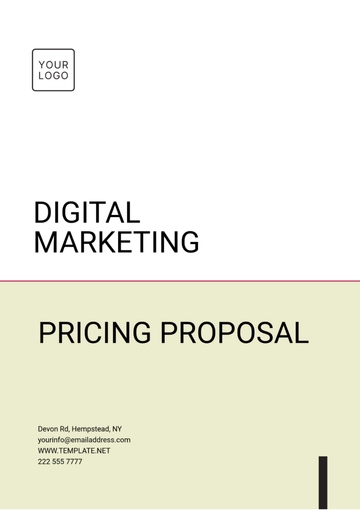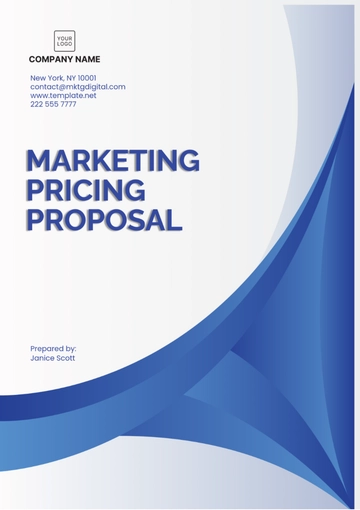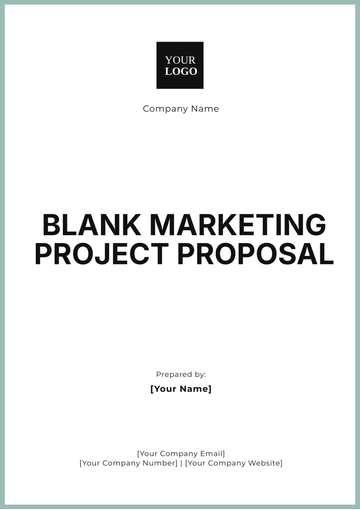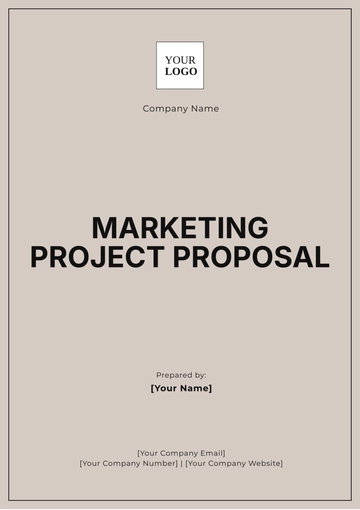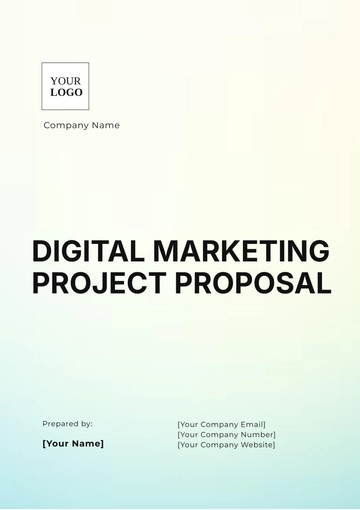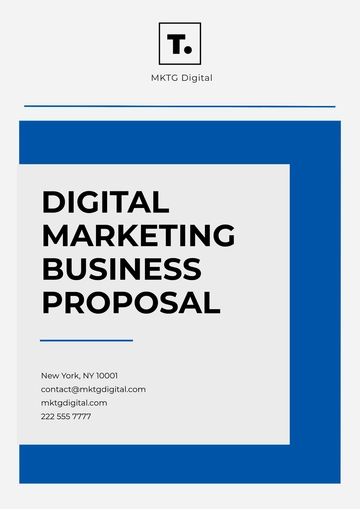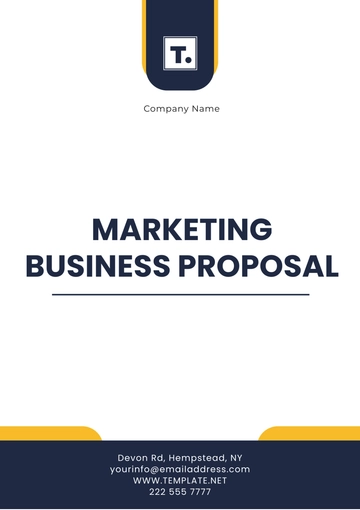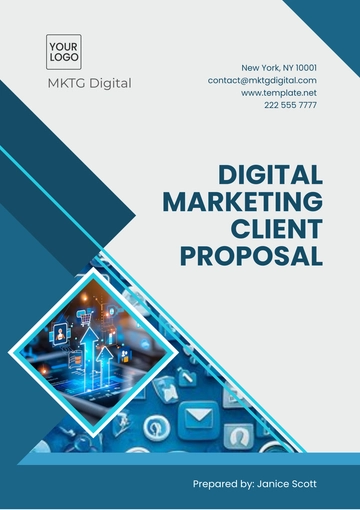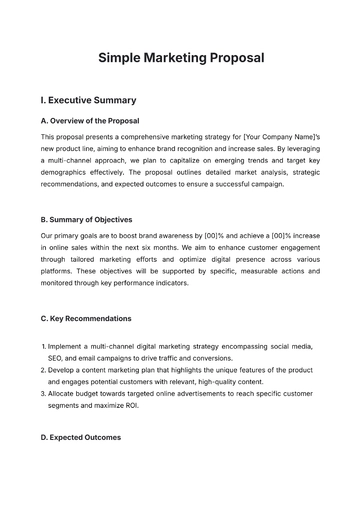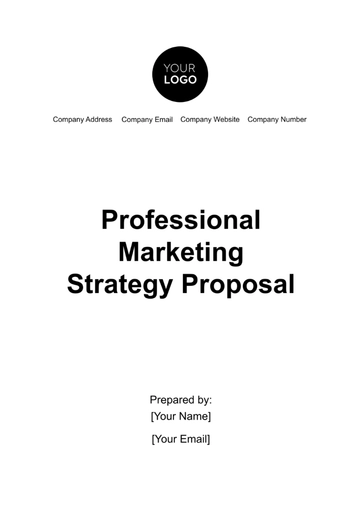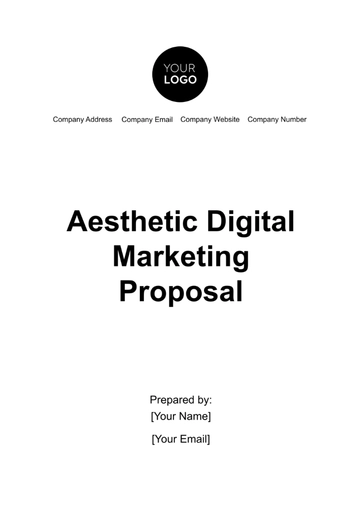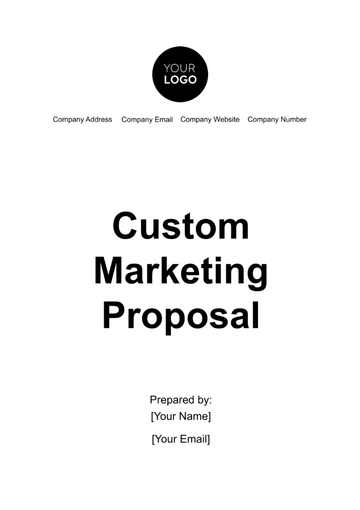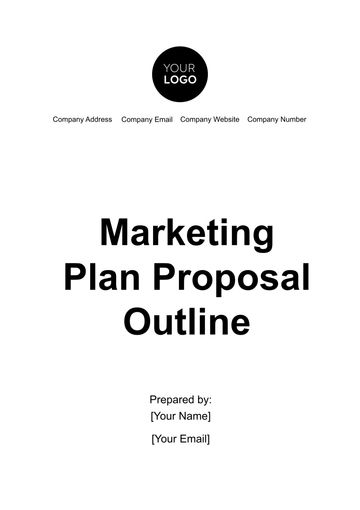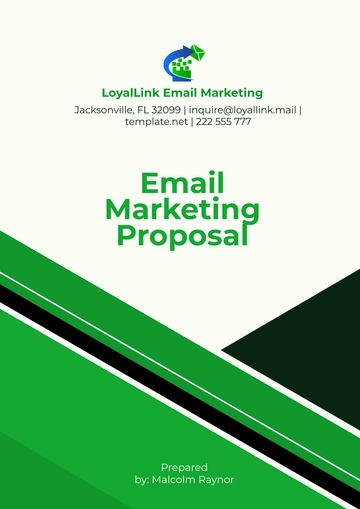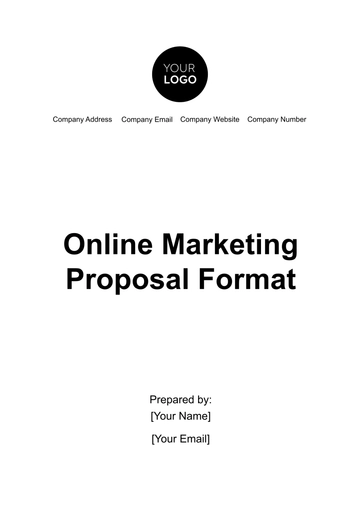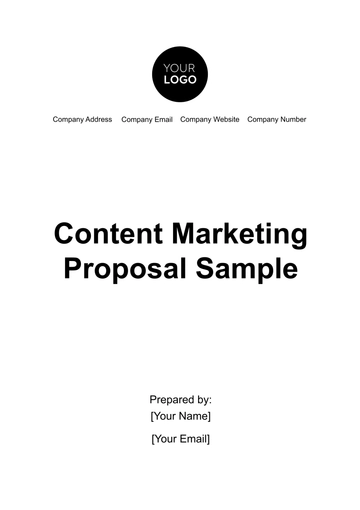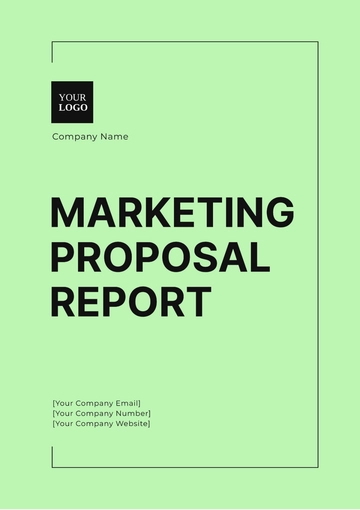Free Startup Digital Marketing Campaign Proposal
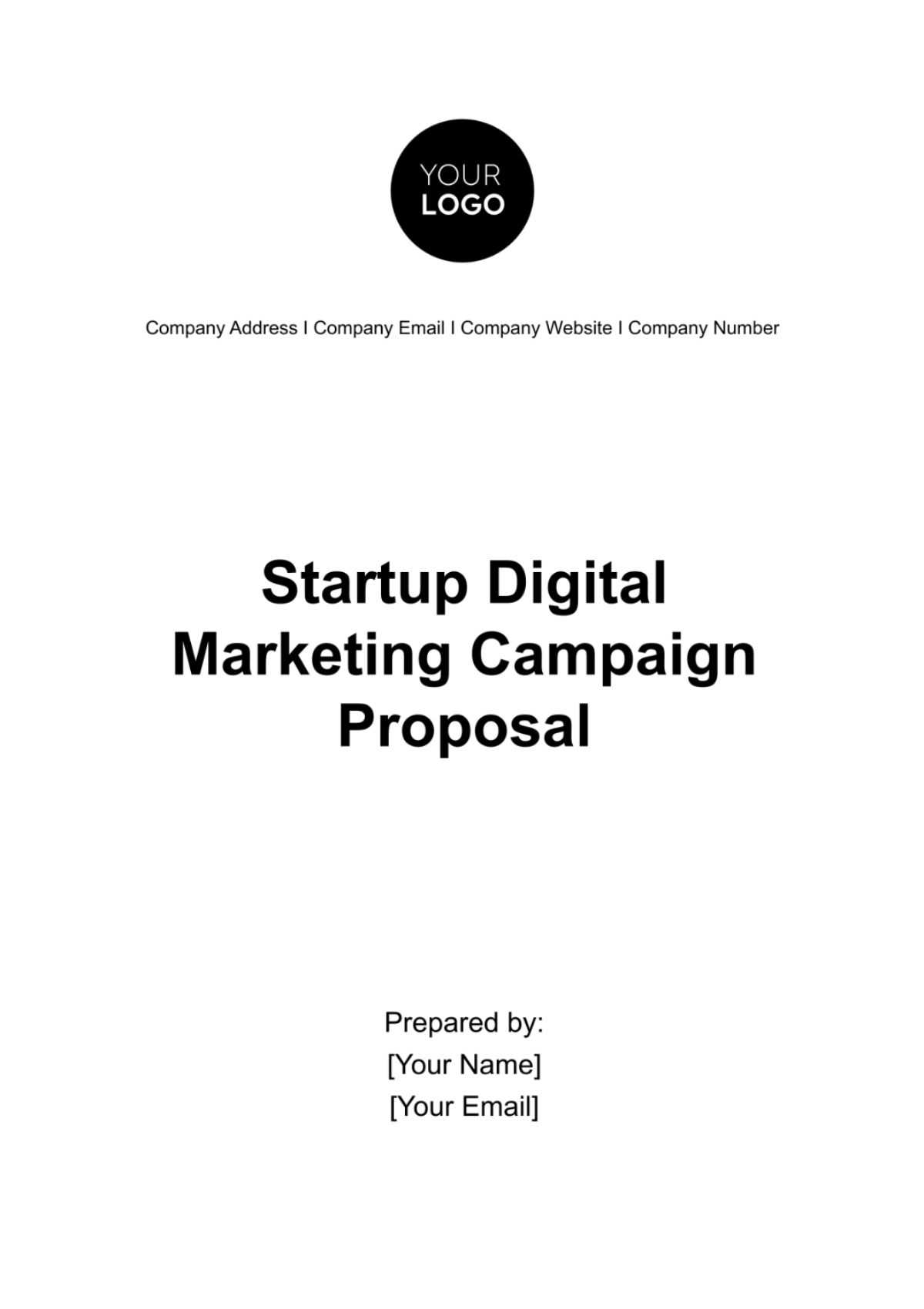
Executive Summary
The following proposal outlines a comprehensive digital marketing campaign for [Your Company Name], aimed at maximizing brand visibility, driving qualified traffic to the website, and converting visitors into loyal customers. In an ever-evolving digital landscape, [Your Company Name] recognizes the need to adapt and innovate to stay ahead of the competition. This campaign seeks to leverage the latest digital marketing strategies and technologies to achieve our objectives effectively.
Key objectives of the campaign include:
Increasing brand mentions and engagement on social media platforms by [00%] over the next six months.
Driving a [00%] increase in organic website traffic through search engine optimization (SEO) and content marketing initiatives.
Generating a minimum [000] high-quality leads through targeted email marketing and lead generation campaigns.
By implementing a strategic blend of content creation, social media engagement, email automation, and paid advertising, [Your Company Name] aims to create a cohesive digital presence that resonates with our target audience. Through consistent messaging and personalized experiences, we strive to build lasting relationships with our customers and drive sustainable business growth.
Introduction
[Your Company Name] is a dynamic player in the technology industry, specializing in providing innovative software solutions for businesses across various sectors. Our overarching goal is to revolutionize the way businesses operate by leveraging cutting-edge technology to streamline processes, enhance productivity, and drive growth.
With a strong focus on innovation and customer-centricity, we are committed to delivering solutions that not only meet but exceed the expectations of our clients. Our team of experts is dedicated to pushing the boundaries of technology to create products and services that make a meaningful impact on our clients' businesses.
Our target market consists of small to medium-sized businesses (SMBs) in industries such as finance, healthcare, and retail. These businesses are looking for scalable and customizable software solutions that can address their unique needs and challenges. Our target audience includes business owners, managers, and IT professionals who are seeking innovative solutions to improve efficiency, increase profitability, and gain a competitive edge in their respective markets.
We understand the pain points, aspirations, and preferences of our target audience, and we tailor our marketing efforts to resonate with their needs effectively. Whether it's through social media engagement, email marketing campaigns, or content creation, we strive to connect with our audience on a deeper level and provide solutions that enrich their lives and drive business success.
Objectives
The primary objectives of the digital marketing campaign for [Your Company Name] are to increase brand awareness, drive website traffic, and generate leads. These objectives are aligned with the overarching goals of the company and are designed to enhance its online presence and market positioning. The following SMART objectives have been defined to guide the campaign:
Objective | Description | Key Metrics |
|---|---|---|
Increase brand awareness | Enhance brand visibility and recognition among the target audience through social media and content marketing efforts. | Social media mentions, reach, brand sentiment |
Drive website traffic | Increase the number of visitors to the [Your Company Name] website by improving organic search rankings and implementing targeted advertising campaigns. | Website visits, organic search traffic, referral traffic |
Generate leads | Capture high-quality leads through strategic email marketing campaigns, lead magnets, and website optimization techniques. | Lead conversion rate, lead quality, email open and click-through rates |
These objectives are specific, measurable, achievable, relevant, and time-bound, providing a clear framework for evaluating the success of the digital marketing campaign. By focusing on these key objectives, [Your Company Name] aims to achieve tangible results and drive sustainable growth in the digital space.
Target Audience
The target audience for [Your Company Name] consists of tech-savvy individuals and businesses seeking innovative solutions to streamline their operations and enhance productivity. This audience segment represents approximately 60% of the total addressable market and is characterized by its:
Demographic: The target audience includes individuals aged 25-45, predominantly male, located in urban and suburban areas across the United States.
Psychographic: They are early adopters of technology, value efficiency and productivity, and are open to trying new tools and solutions.
Interests: They are interested in technology trends, entrepreneurship, and business growth strategies.
Online Behavior: They are active on LinkedIn, Twitter, and industry-specific forums and communities, where they frequently engage with content related to software solutions, productivity hacks, and business development.
Understanding the preferences and pain points of this audience segment is crucial for tailoring the digital marketing campaigns and messaging to resonate with their needs and interests. Through targeted marketing efforts and personalized communication, [Your Company Name] aims to establish meaningful connections with its target audience and drive engagement, conversions, and loyalty across various digital channels.
Competitor Analysis
A thorough analysis of competitors in the [industry/sector] reveals valuable insights into their digital marketing strategies, strengths, weaknesses, opportunities, and threats. By understanding the competitive landscape, [Your Company Name] can identify gaps in the market and refine its own digital marketing approach to gain a competitive advantage.
Competitor A
Digital Marketing Strategy:
Utilizes targeted social media ads and influencer partnerships to reach a wide audience, focusing on platforms like Instagram and Twitter for maximum visibility.
Strengths:
Strong brand presence and loyal customer base cultivated through consistent engagement and innovative campaigns, with a particularly high level of engagement on Instagram where user-generated content plays a significant role.
Weaknesses:
Limited engagement on certain social media platforms such as LinkedIn and YouTube, missing out on potential audience segments and failing to capitalize on the professional networking opportunities provided by LinkedIn.
Opportunities:
Expanding into new markets or verticals, leveraging the existing brand reputation and customer loyalty to explore untapped opportunities in adjacent industries or geographical regions.
Threats:
Increased competition from new entrants disrupting the market with novel approaches and aggressive marketing tactics, necessitating constant innovation and differentiation to maintain market share and relevance.
Competitor B
Digital Marketing Strategy:
Focuses on content marketing and SEO to drive organic traffic to their website, positioning themselves as thought leaders in the industry through informative blog posts, case studies, and whitepapers.
Strengths:
High-quality content that resonates with the target audience, establishing credibility and trust among potential customers who value informative and insightful content.
Weaknesses:
Limited social media presence and engagement, missing out on opportunities for real-time interaction and customer feedback that can help inform content strategy and product development decisions.
Opportunities:
Expanding product/service offerings to cater to evolving customer needs and preferences, diversifying revenue streams and capturing additional market share in complementary product categories.
Threats:
Changes in search engine algorithms affecting organic rankings, potentially impacting website visibility and traffic, highlighting the importance of a diversified marketing strategy that includes both organic and paid channels to mitigate the risk of over-reliance on organic search traffic.
Competitor C
Digital Marketing Strategy:
Leverages email marketing automation and retargeting ads to nurture leads and drive conversions, focusing on personalized communication tailored to the specific needs and interests of individual subscribers.
Strengths:
Effective lead nurturing strategies resulting in high conversion rates, maximizing the ROI of marketing efforts and driving significant revenue growth from existing leads and customers.
Weaknesses:
Limited brand awareness compared to larger competitors with extensive marketing budgets and resources, requiring more targeted and strategic marketing efforts to increase brand visibility and recognition.
Opportunities:
Expanding into international markets, leveraging successful domestic strategies to penetrate new regions and demographics, and capitalize on the growing global demand for digital solutions and services.
Threats:
Rapid changes in consumer behavior impacting email open rates, necessitating continuous adaptation and optimization of email campaigns to maintain engagement levels and drive meaningful results amidst evolving consumer preferences and habits.
By analyzing the digital marketing strategies of key competitors, [Your Company Name] can identify areas of opportunity and potential threats to inform its own marketing initiatives. This competitive intelligence will guide the development of targeted campaigns and tactics to effectively reach and engage with the target audience.
Digital Marketing Strategy
[Your Company Name] will implement a comprehensive digital marketing strategy focused on maximizing brand exposure, driving website traffic, and converting leads into customers. The strategy will encompass various digital channels and tactics tailored to the preferences and behaviors of the target audience.
A. Content Marketing
[Your Company Name] will develop high-quality, informative content relevant to the target audience's interests and pain points. This will include blog posts, articles, whitepapers, case studies, and infographics designed to educate and engage prospects throughout the buyer's journey. By providing valuable insights and solutions to common challenges, [Your Company Name] will position itself as a thought leader in the industry and attract organic traffic to its website.
B. Social Media Marketing
[Your Company Name] will leverage social media platforms such as LinkedIn, Twitter, and Facebook to increase brand awareness and engage with the target audience. The strategy will involve regular posting of relevant content, participation in industry discussions, and interaction with followers to foster meaningful connections. Additionally, [Your Company Name] will run targeted advertising campaigns to reach specific audience segments and drive traffic to its website.
C. Email Marketing
[Your Company Name] will implement strategic email marketing campaigns to nurture leads and guide them through the sales funnel. This will involve segmenting the email list based on demographics, interests, and engagement levels to deliver personalized content and offers. Automated workflows will be set up to deliver timely and relevant messages, such as welcome emails, product recommendations, and abandoned cart reminders, to drive conversions and maximize ROI.
D. Paid Advertising
[Your Company Name] will utilize paid advertising channels such as Google Ads and social media advertising to expand its reach and drive targeted traffic to its website. This will involve identifying relevant keywords and audience segments, creating compelling ad copy and visuals, and optimizing campaigns for maximum performance. Retargeting ads will be used to re-engage website visitors and encourage them to take action, such as signing up for a demo or making a purchase.
By implementing a cohesive digital marketing strategy that encompasses content marketing, social media marketing, email marketing, and paid advertising, [Your Company Name] aims to achieve its objectives of increasing brand visibility, driving website traffic, and generating leads. Continuous monitoring and optimization of campaigns will ensure that [Your Company Name] remains agile and responsive to changes in the digital landscape, ultimately driving sustainable growth and success.
Budget Allocation
The success of the digital marketing campaign for [Your Company Name] relies on strategic allocation of resources across various channels and tactics. The following table outlines the proposed budget allocation for each component of the campaign:
Channel | Budget Allocation |
|---|---|
Content Marketing | [$00,000] |
Social Media Marketing | [$00,000] |
Email Marketing | [$00,000] |
Paid Advertising | [$00,000] |
Total | [$00,000] |
This budget has been carefully allocated based on the anticipated impact of each channel on achieving the campaign objectives. By investing in a balanced mix of content creation, social media engagement, email automation, and paid advertising, [Your Company Name] aims to maximize its return on investment (ROI) and drive measurable results.
A. Content Marketing
The allocated budget for content marketing will be used to produce high-quality, informative content that resonates with the target audience. This includes blog posts, articles, videos, and infographics that address the pain points and interests of potential customers. Additionally, funds will be allocated for content distribution and promotion to increase visibility and engagement.
B. Social Media Marketing
The budget for social media marketing will cover the costs associated with running paid advertising campaigns on platforms such as Facebook, Instagram, and LinkedIn. This includes ad creative development, audience targeting, and campaign management fees. Additionally, funds will be allocated for organic social media efforts, including content creation, community management, and influencer partnerships.
C. Email Marketing
The allocated budget for email marketing will be used to invest in email automation software, design and development of email templates, and list segmentation tools. Additionally, funds will be allocated for email deliverability testing, tracking, and analytics to optimize campaign performance and drive conversions.
D. Paid Advertising
The budget for paid advertising will cover the costs associated with running Google Ads, display ads, and retargeting campaigns. This includes keyword research, ad copywriting, bid management, and ongoing optimization to maximize ROI. Additionally, funds will be allocated for tracking and analytics tools to monitor campaign performance and make data-driven decisions.
Timeline
The digital marketing campaign for [Your Company Name] will be implemented over a period of six months, divided into key phases and milestones. The following timeline provides an overview of the planned activities and deliverables:
Phase | Duration Activities |
|---|---|
Phase 1: Planning & Setup | Month 1 Conduct market research and competitor analysis. Define target audience and objectives. Set up tracking and analytics tools. |
Phase 2: Content Creation | Months 2-3 Develop content calendar and create engaging content for blog posts, social media, and email campaigns. Optimize website content for SEO. |
Phase 3: Campaign Launch | Month 4 Launch social media advertising campaigns. Implement email marketing automation. Start paid advertising campaigns. |
Phase 4: Optimization & Testing | Months 5-6 Monitor campaign performance and make adjustments as needed. Conduct A/B testing on ad creatives and landing pages. Refine targeting and messaging based on data insights. |
Phase 5: Evaluation & Reporting | Month 6 Analyze campaign results against KPIs. Prepare comprehensive report highlighting key findings, successes, and areas for improvement. |
By adhering to this timeline and executing each phase with precision and attention to detail, [Your Company Name] will ensure the smooth implementation and successful outcome of the digital marketing campaign. Regular monitoring and optimization throughout the campaign will enable [Your Company Name] to adapt to changing market conditions and maximize the impact of its marketing efforts.
Key Performance Indicators (KPIs)
The success of the digital marketing campaign for [Your Company Name] will be evaluated based on key performance indicators (KPIs) that align with the campaign objectives. The following table outlines the KPIs that will be monitored and measured throughout the campaign:
KPI | Description | Target Goal |
|---|---|---|
Social Media Mentions | Number of times [Your Company Name] is mentioned on social media platforms. | Increase by 20% from baseline |
Website Traffic | Number of visitors to the [Your Company Name] website from organic and paid sources. | Achieve a 30% increase compared to the previous period |
Lead Generation | Number of high-quality leads captured through email sign-ups, contact forms, or downloads. | Generate a minimum of 500 leads within the campaign duration |
Conversion Rate | Percentage of website visitors who take a desired action, such as making a purchase or requesting a demo. | Increase by 5% compared to the previous period |
Return on Investment (ROI) | Ratio of the net profit generated from the digital marketing campaign to the total cost of investment. | Achieve a minimum ROI of 3:1 |
By tracking these KPIs regularly and comparing them against predetermined targets, [Your Company Name] will be able to assess the effectiveness of the digital marketing campaign and make data-driven decisions to optimize performance and achieve desired outcomes.
Reporting and Analysis
Regular reporting and analysis will be conducted throughout the duration of the digital marketing campaign to evaluate performance, identify areas for improvement, and make informed decisions. The following reporting schedule outlines the frequency and format of reports:
Reporting Frequency | Report Format | Audience |
|---|---|---|
Weekly | Brief summary highlighting key metrics and trends. | Internal marketing team |
Monthly | Comprehensive report detailing campaign performance against KPIs. Includes insights and recommendations for optimization. | Executive team, stakeholders |
End of Campaign | Final report summarizing overall campaign performance, lessons learned, and recommendations for future initiatives. | Executive team, stakeholders |
These reports will provide valuable insights into the effectiveness of the digital marketing strategies and tactics deployed by [Your Company Name]. By leveraging data and analytics, [Your Company Name] will be able to refine its approach, allocate resources more effectively, and drive continuous improvement in its digital marketing efforts. Regular communication and transparency will ensure that all stakeholders are informed and aligned with the campaign objectives and outcomes.
Risk Management
The digital marketing campaign for [Your Company Name] may face various risks and challenges that could impact its success. To mitigate these risks and ensure the smooth execution of the campaign, a risk management plan has been developed. The following table outlines potential risks, their impact, likelihood, and mitigation strategies:
Risk | Impact | Likelihood | Mitigation Strategy |
|---|---|---|---|
Changes in Algorithm | High | Medium | Stay updated with search engine algorithm changes and adapt SEO strategies accordingly. Diversify traffic sources to reduce reliance on organic search. |
Ad Budget Overrun | Medium | Low | Monitor ad spend closely and adjust budgets as needed. Set clear spending limits and track expenses against allocated budget. |
Low Engagement on Social Media | Medium | Medium | Monitor social media performance metrics regularly. Experiment with different types of content and engagement strategies. |
Email Deliverability Issues | High | Low | Maintain a clean email list and adhere to best practices for email marketing. Monitor email deliverability metrics and address any issues promptly. |
Technical Glitches | Medium | Low | Regularly monitor website performance and functionality. Have a contingency plan in place for resolving technical issues quickly. |
By identifying potential risks and implementing proactive mitigation strategies, [Your Company Name] aims to minimize disruptions and ensure the successful implementation of the digital marketing campaign.
Conclusion
The digital marketing campaign proposed for [Your Company Name] represents a strategic approach to expanding its online presence, reaching its target audience, and achieving its marketing objectives. By leveraging various digital channels and tactics, including content marketing, social media marketing, email marketing, and paid advertising, [Your Company Name] aims to increase brand awareness, drive website traffic, and generate leads.
Through careful planning, execution, and monitoring, [Your Company Name] will be able to evaluate the effectiveness of the campaign, optimize performance, and drive sustainable growth in the digital realm. By regularly tracking key performance indicators and conducting thorough analysis and reporting, [Your Company Name] will gain valuable insights into consumer behavior, market trends, and campaign effectiveness, enabling informed decision-making and continuous improvement.
With a focus on innovation, creativity, and customer-centricity, [Your Company Name] is poised to elevate its digital presence and solidify its position as a leader in the [industry/sector]. By staying agile, responsive, and adaptable to changes in the digital landscape, [Your Company Name] will be well-positioned for success now and in the future.
Thank you for considering this digital marketing campaign proposal. We look forward to the opportunity to partner with you and drive tangible results for [Your Company Name].
- 100% Customizable, free editor
- Access 1 Million+ Templates, photo’s & graphics
- Download or share as a template
- Click and replace photos, graphics, text, backgrounds
- Resize, crop, AI write & more
- Access advanced editor
Introducing the Startup Digital Marketing Campaign Proposal Template from Template.net. This versatile template offers startups a customizable and editable framework to pitch compelling digital marketing campaigns. Crafted with efficiency in mind, it's tailored for your convenience and editable using our intuitive Ai Editor Tool. Propel your startup's marketing efforts with a winning proposal today!
You may also like
- Business Proposal
- Research Proposal
- Proposal Request
- Project Proposal
- Grant Proposal
- Photography Proposal
- Job Proposal
- Budget Proposal
- Marketing Proposal
- Branding Proposal
- Advertising Proposal
- Sales Proposal
- Startup Proposal
- Event Proposal
- Creative Proposal
- Restaurant Proposal
- Blank Proposal
- One Page Proposal
- Proposal Report
- IT Proposal
- Non Profit Proposal
- Training Proposal
- Construction Proposal
- School Proposal
- Cleaning Proposal
- Contract Proposal
- HR Proposal
- Travel Agency Proposal
- Small Business Proposal
- Investment Proposal
- Bid Proposal
- Retail Business Proposal
- Sponsorship Proposal
- Academic Proposal
- Partnership Proposal
- Work Proposal
- Agency Proposal
- University Proposal
- Accounting Proposal
- Real Estate Proposal
- Hotel Proposal
- Product Proposal
- Advertising Agency Proposal
- Development Proposal
- Loan Proposal
- Website Proposal
- Nursing Home Proposal
- Financial Proposal
- Salon Proposal
- Freelancer Proposal
- Funding Proposal
- Work from Home Proposal
- Company Proposal
- Consulting Proposal
- Educational Proposal
- Construction Bid Proposal
- Interior Design Proposal
- New Product Proposal
- Sports Proposal
- Corporate Proposal
- Food Proposal
- Property Proposal
- Maintenance Proposal
- Purchase Proposal
- Rental Proposal
- Recruitment Proposal
- Social Media Proposal
- Travel Proposal
- Trip Proposal
- Software Proposal
- Conference Proposal
- Graphic Design Proposal
- Law Firm Proposal
- Medical Proposal
- Music Proposal
- Pricing Proposal
- SEO Proposal
- Strategy Proposal
- Technical Proposal
- Coaching Proposal
- Ecommerce Proposal
- Fundraising Proposal
- Landscaping Proposal
- Charity Proposal
- Contractor Proposal
- Exhibition Proposal
- Art Proposal
- Mobile Proposal
- Equipment Proposal
- Student Proposal
- Engineering Proposal
- Business Proposal

